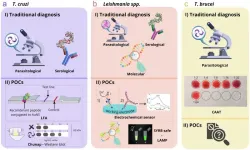In the next five years, integrating AI into country response systems could save more lives by anticipating the location and trajectory of disease outbreaks. Global group of researchers call for better collaboration between academia, government and industry, to ensure safety, accountability and ethics in the use of AI in infectious disease research. A study published in Nature today outlines for the first time how advances in AI can accelerate breakthroughs in infectious disease research and outbreak response.
The study – which is published following last week’s AI Action Summit and amidst increasing global debate on AI investment and regulation – puts particular emphasis on safety, accountability and ethics in the deployment and use of AI in infectious disease research.
Calling for a collaborative and transparent environment – both in terms of datasets and AI models – the study is a partnership between scientists from the University of Oxford and colleagues from academia, industry and policy organisations across Africa, America, Asia, Australia and Europe.
So far, medical applications of AI have predominantly focused on individual patient care, enhancing for example clinical diagnostics, precision medicine, or supporting clinical treatment decisions.
This review instead considers the use of AI in population health. The study finds that recent advances in AI methodologies are performing increasingly well even with limited data – a major bottleneck to date. Better performance on noisy and limited data is opening new areas for AI tools to improve health across both high-income and low-income countries.
Lead author Professor Moritz Kraemer from the University of Oxford’s Pandemic Sciences Institute, said: “In the next five years, AI has the potential to transform pandemic preparedness.
“It will help us better anticipate where outbreaks will start and predict their trajectory, using terabytes of routinely collected climatic and socio-economic data. It might also help predict the impact of disease outbreaks on individual patients by studying the interactions between the immune system and emerging pathogens.
“Taken together and if integrated into countries’ pandemic response systems, these advances will have the potential to save lives and ensure the world is better prepared for future pandemic threats.”
Opportunities for AI and pandemic preparedness identified in the research include:
Promising advances in improving current models of disease spread, aiming to make modelling more robust, accurate and realistic. Progress in pinpointing areas of high-transmission potential, helping ensure limited healthcare resources can be allocated in the most efficient possible way. Potential to improve genetic data in disease surveillance, ultimately accelerating vaccine development and the identification of new variants. Potential to help determine the properties of new pathogens, predict their traits and identify whether cross species jumps are likely. Predicting which new variants of already-circulating pathogens – such as SARS-CoV-2 and influenza viruses – might arise, and which treatments and vaccines are best in reducing their impact. Possible AI-aided integration of population-level data with data from individual-level sources – including wearable technologies such as heart rate and step counts – to better detect and monitor outbreaks. AI can create a new interface between the highly technical science and healthcare professionals with limited training, improving capacity in settings that need these tools the most. Not all areas of pandemic preparedness and response will be equally impacted by advances in AI, however. For example, whereas protein language models hold great promise for speeding up understanding of how virus mutations can impact disease spread and severity, advances in foundational models might only provide modest improvements over existing approaches to modelling the speed at which a pathogen is spreading.
The scientists urge caution in suggesting that AI alone will solve infectious disease challenges, but that integration of human feedback into AI modelling workflows might help overcome existing limitations.
The authors are particularly concerned with the quality and representativeness of training data, the limited accessibility of AI models to the wider community, and potential risks associated with the deployment of black-box models for decision making.
Study author Professor Eric Topol, MD, founder and director of the Scripps Research Translational Institute, said: “While AI has remarkable transformative potential for pandemic mitigation, it is dependent upon extensive worldwide collaboration and from comprehensive, continuous surveillance data inputs.”
Study lead author Samir Bhatt from the University of Copenhagen and Imperial College London said: “Infectious disease outbreaks remain a constant threat, but AI offers policymakers a powerful new set of tools to guide informed decisions on when and how to intervene.”
The authors suggest rigorous benchmarks to evaluate AI models, advocating for strong collaborations between government, society, industry and academia for sustainable and practical development of models for improving human health.
Read the paper in Nature: https://www.nature.com/articles/s41586-024-08564-w
DOI: 10.1038/s41586-024-08564-w
ENDS
--
Notes to editors:
For media enquiries and requests for interview contact: Sarah Nelson, Head of Communications, Pandemic Sciences Institute, University of Oxford: sarah.nelson@ndm.ox.ac.uk / +447812 152044
The study’s authors include scientists from the University of Oxford (Pandemic Sciences Institute; Oxford Martin School; Department of Biology; Oxford Vaccine Group; Department of Computer Science; Department of Statistics; Doctoral Training Centre; Ethox Centre); Stanford University; the University of Tokyo; University of Copenhagen; NIHR Oxford Biomedical Research Centre; Imperial College London; Northeastern University, Boston; Santa Fe Institute; World Health Organization; Stellenbosch University; African Institute for Mathematical Sciences (AIMS); Genomics England; Scripps Research, la Jolla, CA; ETH Zürich; Swiss Institute of Bioinformatics; Harvard T.H. Chan School of Public Health; The Open Data Institute, London; University of California, Los Angeles; The University of Sydney; Max Planck Institute for Software Systems; Max Planck Institute for Intelligent Systems; ELLIS Institute Tübingen, Germany; The Royal Veterinary College, London; Institut Pasteur, Paris, France.
The Pandemic Sciences Institute is an interdisciplinary research institute at the University of Oxford dedicated to confronting the challenge of epidemic and pandemic infectious diseases. We work with academia, industry and public health organisations across the world to create science-led innovations, accelerate understanding, and develop new diagnostics, treatments, vaccines and disease control tools. PSI is hosted by the University’s Nuffield Department of Medicine.
END


